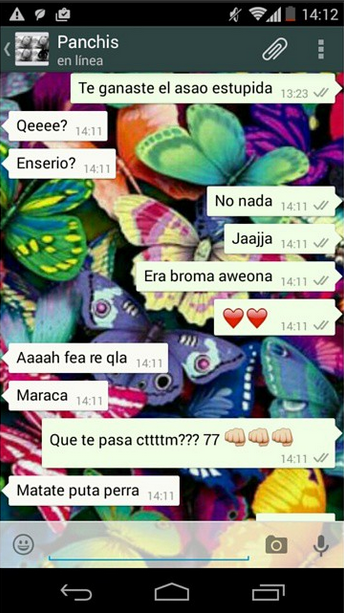For part one, click here: facebook: the facts
For part three, click here: twitter: the facts
For part four, click here: instagram: the facts
Whatsapp is certainly the second most important form of social networking communication in Alto Hospicio. Of people in the survey who use social networking applications, 77% use Whatsapp regularly and two-thirds of them regularly communicate in groups with the application. It tends to be used only slightly more with friends than with family members. When meeting new people, they almost always asked if I had Whatsapp rather than wanting to connect through email, Facebook, or by exchanging phone numbers. Police officers, internet installation technicians, and neighbors alike preferred the new app to older ways of getting in contact.
WhatsApp is much like “traditional” text messaging, but requires the user to download an application to their smartphone. Then they can send messages using their mobile data rather than messaging bundle. Though Whatsapp allows for users to send videos to their contacts, this use was rare among people in Alto Hospicio. Far more common were sending photos. Voice messages were even more popular. Some people blamed this on laziness. “I’m too lazy to type, just pressing the button and talking is easier,” though others were concerned about others around them hearing the message when a friend, partner, or even ex-partner sent a voice message.
For teens, Whatsapp use is incredibly high. Eighty five percent of respondents under 20 used Whatsapp, and 70% of them often sent and received messages to groups with an average of 2.6 groups per person. Seventy six percent use it with friends, 35% with their boyfriend or girlfriend, and less than one quarter with family members, and overall more than three quarters of the time with someone in Alto Hospicio. Boyfriends and girlfriends will often spend afterschool or late night hours writing back and forth. Friends use it for the latest school gossip or to make weekend plans. This is true with siblings as well, though most live in the same home, so are able to speak in person more often. Most often, when a teens uses Whatsapp to communicate with a family member, it is their mother, and the conversation consists of checking in, requests from the supermarket, or asking about daily plans.
For people in their twenties, Whatsapp is even more important, with 90% of those surveyed saying they use Whatsapp at least once a day. Seventy percent those users send at least one group message per day using Whatsapp, but usually reported being part of only 1-3 Whatsapp groups. Whatsapps were far more used than “traditional” text messages, and were mostly used with friends or romantic partners rather than parents, siblings, or children.
The peak age for Whatsapp use seems to be between 25 and 30 years, and after that begins to drop off a little. Seventy-five percent of those 30-34 use Whatsapp and 67% of those 35-39. Only 33% of people in their 40s use it, and only 20% of those surveyed over 50, most of those above 40 who use Whatsapp do it solely with individuals rather than with groups. For those above 30 Whatsapp is only slightly more popular than text messaging, and is used primarily with family members, and for fewer people with friends.
Of course, Whatsapp is slightly harder to study than Facebook, because there is no public record of the interactions. However, I was fortunate to be included in a few groups while doing fieldwork. The first was a group that was maintained over a long period of time, and was primarily aimed at men who liked to drive their trucks and motorcycles out into the sand dunes that surround the city. The group, called the Red Offroading Club had existed long before Whatsapp as a driving club, but Whatsapp allowed them to organize more easily. Without fail, every weekend (and sometimes on weekdays) one of the men would write to the group asking who would like to go out to the hills that afternoon. Many would reply with their specific commitments that would keep them from joining, but usually at least a few people would be interested in a drive. The conversation would then turn to logistics about time of departure and a place to meet. Inevitably, someone would have a motor problem and need a tow or something fixed or a spare part, and those such problems were always resolved through Whatsapp also. However, pictures taken during the outings, of which there were usually dozens, were always shared on Facebook rather than the Whatsapp group.
A few times, this group was also used to organize parties on the sand dunes. Logistical conversations would begin mid-week, with questions of whether Friday night or Saturday night was more amenable to people. Once that was decided, it was important to make sure everyone who wanted to come had a ride, because it wouldn’t be a party if all the trucks weren’t full! Coordinating beverages and music all happened through the group, as well as harassment of friends when it was after midnight and they still hadn’t arrived to the party. But again, the pictures taken at the party, lit by a flaming tire that had been discarded on the hillside, were posted on Facebook rather than shared with the Whatsapp group.

 RSS Feed
RSS Feed
